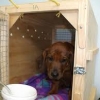
Tips for Moving with Your Pets
By Budget Trucks|September 30, 2014
If you are planning a move in the near future, it is important to start thinking ahead for your pets. Make sure to add a pet moving checklist to all of the other important tasks that go along with moving. The key for reducing stress and making any move easier is planning ahead. Making sure that your pets are taken care of before, during, and after your move will make the transition much easier for everyone.
Before Your Move
Planning ahead for your move includes making a separate checklist for your pets. Cats and dogs are the most common household pets and need more attention than other smaller pets that live in a cage or a tank. If you happen to have exotic animals, you should check with your pet’s veterinarian to see if there are any special considerations to make for them when moving. Climates and other changes in temperature and light might affect exotic pets differently. Our moving tips here mostly apply to cats and dogs, but may also be helpful if you have any other type of pet.
Here is a list of things you can do to prepare ahead of time for your move. The more organized and calm you are will reflect how your pets feel. They almost always understand our moods and emotions more than we think.
During Your Move
On moving day, the tips to help your pets get through the actual move depend on whether you are driving or renting a moving truck or flying to your new home. Either way, you will want to have a bag of things available for your pet including their blanket, pillow, toys, medications, and important documents. Below are the two sets of tips depending on how you are getting to your new home.
Flying to Your New Home:
Before Your Move
Planning ahead for your move includes making a separate checklist for your pets. Cats and dogs are the most common household pets and need more attention than other smaller pets that live in a cage or a tank. If you happen to have exotic animals, you should check with your pet’s veterinarian to see if there are any special considerations to make for them when moving. Climates and other changes in temperature and light might affect exotic pets differently. Our moving tips here mostly apply to cats and dogs, but may also be helpful if you have any other type of pet.
Here is a list of things you can do to prepare ahead of time for your move. The more organized and calm you are will reflect how your pets feel. They almost always understand our moods and emotions more than we think.
- Make an Appointment with the Veterinarian. Even if it is not yet time for your pet’s annual or semi-annual checkup, you should still see your vet so that he or she can evaluate your pet and do a full examination. There are two reasons for this. One is that you want to make sure there aren’t any underlying issues that might be exacerbated by the stress of a move. Catching them early and treating them ahead of time will avoid having a problem during the stressful time of the last minute packing and moving. The second reason especially applies if you are moving out of your area and will not be able to continue seeing the same vet. During your visit, make sure that your pets are all up-to-date with their shots and get them micro-chipped if they aren’t already. A new environment increases the likelihood your pet might get lost. If you are going to need to change vets, you should also ask for a copy of their medical history to give to the new veterinarian.
- Pick Out the Proper Carrier. At some point during your move, your pet will likely need to be in a carrier or crate of some kind. If you already have a carrier, there are some preparations you need to make. First of all, make sure that the carrier you have is the right size for your pet and they have not outgrown it. If you are flying during your move, you will want to make sure you’re your carrier meets the regulations and be sure to purchase a “Live Animal” stick for the carrier.
- Pack Your Pet’s Essentials for the Move. Keep a separate bag with the food, water, and toys for your pet to use during the move. When you have this on your list, you won’t make the mistake of packing up all of the things your pet will need or want on moving day. Keep all of your pertinent pet documents with you to show ownership, medical history, etc.
During Your Move
On moving day, the tips to help your pets get through the actual move depend on whether you are driving or renting a moving truck or flying to your new home. Either way, you will want to have a bag of things available for your pet including their blanket, pillow, toys, medications, and important documents. Below are the two sets of tips depending on how you are getting to your new home.
Flying to Your New Home:
- Have all of your pertinent pet documents with you in case anyone questions ownership or medical history, vaccination information, etc.
- Put your “Live Animal” sticker on your pet’s carrier along with a recent picture of your pet and a name tag for identification.
- Fasten your pet’s collar on tightly and be sure that the tag is updated with your new contact information with your new address.
- Try to book a direct flight if possible.
- Don’t forget any prescriptions for your pet including any calming medications or all natural alternatives.
- Even if you are driving or in a moving truck, you might want to keep your pet in a travel carrier. This is certainly the case for cats, but even for many types of dogs, they will be more comfortable and everyone will be safer in the vehicle.
- If you do opt to let your dog ride in the car, don’t let him or her ride with his or her head hanging out of the car window. Besides the safety considerations, the dirt and debris can cause injury or infection. This will add to your stress and affect their experience of moving into a new home too.
- Plan frequent stops for bathroom breaks and some exercise. This is good for both the humans and dogs in the car.
- Never leave your pet alone in the car. Temperatures in the car get hot very fast. Even if it is cool or cold out, this will likely make your pet very nervous and they might have an accident in your car or chew on something they shouldn’t.
- Keep a small litter box in the car in case of accidents, it can make pick up easier.



